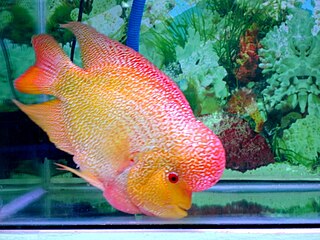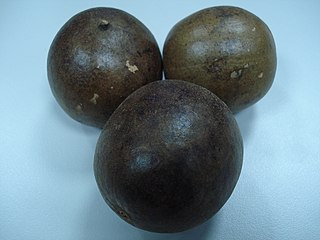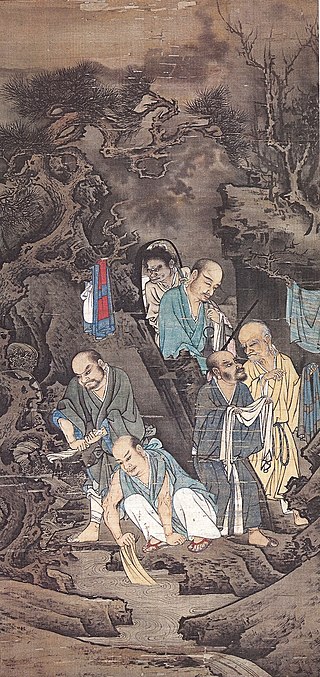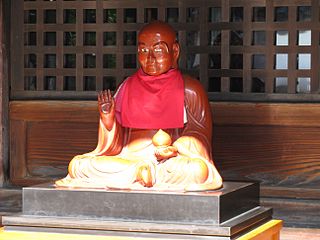Luohan (or "lohan" in older sources) is Chinese for arhat.
Luohan may also refer to:
- Luohan or Flowerhorn cichlid, a cichlid fish hybrid
Luohan (or "lohan" in older sources) is Chinese for arhat.
Luohan may also refer to:

Mizongyi is a style of Chinese martial art based on deception and mobility.
Lohan is a surname. Notable people with the surname include:

Flowerhorn cichlids are ornamental aquarium fish noted for their vivid colors and the distinctively shaped heads for which they are named. Their head protuberance is formally called a nuchal hump. Like blood parrot cichlids, they are hybrids that exist in the wild only because of their release. Flowerhorns first emerged for sale on the aquarium market in Malaysia in the late 1990s and soon became popular in many countries in Asia. They are commonly kept by hobbyists in the US, Asia, and Europe. Numerous cast-off flowerhorns have been released to the wild, especially in Singapore and Malaysia, where they have become an invasive pest animal. Their importation is banned in Australia.

Siraitia grosvenorii, also known as monk fruit, monkfruit or luohan guo, is a herbaceous perennial vine of the gourd family, Cucurbitaceae. It is native to southern China. The plant is cultivated for its fruit extract, called mogrosides, which creates a sweetness sensation 250 times stronger than sucrose. Mogroside extract has been used as a low-calorie sweetener for drinks and in traditional Chinese medicine.

Luohanquan, which means "Arhat fist", is a general name for all the styles of Chinese martial arts that are named after the Arhats, the holy Buddhist figures. Luohan style is the oldest and the representative style of Shaolin kung fu. The original roots of Luohan style date back to the early eras of Shaolin temple. In Shaolin temple, there are various Luohan styles. Besides the Shaolin Luohan styles, there are many Luohan-related styles that have been developed in many other areas of China. Shaolin Luohan 18 hands and Luohanquan are always praised as the root styles based on which most of the Shaolin kung fu styles and many other non-Shaolin styles have been created.

Lin Tinggui was a Chinese painter of the Southern Song Dynasty. His artwork was greatly influenced by themes of Chinese Buddhism.


Pindola Bharadvaja is an Arhat in Buddhism. According to the earliest Indian Buddhist sutras, Pindola Bharadvaja was one of four Arhats asked by the Buddha to remain in the world to propagate Buddhist law (Dharma). Each of the four was associated with one of the four compass directions.

Wu Bin was a Ming dynasty Chinese landscape painter during the reign of the Wanli Emperor. His courtesy name was "Wenzhong" and his art name "Zhiyin Toutuo" means "Mendicant monk at the temple hidden by tree branches". His specific dates of birth and death are not known. Wu was born in Putian in the Fujian province. The local relation linked him to Ōbaku Buddhism sect. He painted a large Nirvana scene painting for them.

In Buddhism, an arhat or arahant is one who has gained insight into the true nature of existence and has achieved Nirvana and liberated from the endless cycle of rebirth.

The Sixteen Arhats are a group of legendary Arhats in Buddhism. The grouping of sixteen Arhats was brought to China, and later to Tibet, from India. In China, an expanded group of Eighteen Arhats later became much more popular, but worship of the sixteen Arhats still continues to the present day in China, Japan and Tibet. In Japan sixteen Arhats are particularly popular in Zen Buddhism, where they are treated as examples of behaviour. In Tibet, the sixteen Arhats, also known as sixteen sthaviras ('elders') are the subject of a liturgical practice associated with the festival of the Buddha's birth, composed by the Kashmiri teacher Shakyahribhadra (1127-1225). They are also well represented in Tibetan art.
Arihant, Arihanta, Arahant or Arhat may refer to:
The Eighteen Arhats are depicted in Chinese Buddhism as the original followers of Gautama Buddha (arhat) who have followed the Noble Eightfold Path and attained the four stages of enlightenment. They have reached the state of Nirvana and are free of worldly cravings. They are charged to protect the Buddhist faith and to wait on earth for the coming of Maitreya, an enlightened Buddha prophesied to arrive on earth many millennia after Gautama Buddha's death (parinirvana). In China, the eighteen arhats are also a popular subject in Buddhist art, such as the famous Chinese group of glazed pottery luohans from Yixian from about 1000 CE.

Guanxiu was a celebrated Buddhist monk, painter, poet, and calligrapher. His greatest works date from the Five Dynasties and Ten Kingdoms period. The collapse of the central Tang government in 907, meant artists and craftsmen lost their most powerful patrons. The imperial Tang court had inspired a golden age of literature and art at its apogee. The various provincial courts who claimed to represent a continuation of the tradition of Tang government also claimed continuity in the arts and culture. The state of the Former Shu had acted as the traditional western sanctuary ever since Emperor Xuanzong had sought refuge there during the An Shi Rebellion in 755. By the collapse of the Tang Dynasty something like a miniature Tang court existed at Chengdu. Guanxiu arrived in Chengdu in 901, and remained there until his death.

A set of life-size glazed pottery sculptures of luohans usually assigned to the period of the Liao dynasty (907–1125) was discovered in caves at I Chou in Yi xian or Yi County, Hebei, south of Beijing, before World War I. They have been described as "one of the most important groups of ceramic sculpture in the world." They reached the international art market, and were bought for Western collections. At least eight statues were originally found, including one large fragment which was thought to have been destroyed in Berlin during World War II, but was rediscovered in the State Hermitage Museum, St Petersburg, in 2001.

Buddha's delight, often transliterated as Luóhàn zhāi, lo han jai, or lo hon jai, is a vegetarian dish well known in Chinese and Buddhist cuisine. It is sometimes also called Luóhàn cài.

Luohan Temple is a Buddhist temple located in Yuzhong District, Chongqing. It is the site of the Buddhist Association of Chongqing. The temple was used for Ning Hao's black comedy film Crazy Stone.
Luohan Temple, may refer to:
Luohan Temple is a Buddhist temple located in Shifang, Sichuan, China. The temple is known as the "Buddhist Capital of Western Sichuan".

Xianglong Luohan, also known as the Taming Dragon Arhat, is an arhat and one of the Eighteen Arhats in China. His Sanskrit name is Nantimitolo and origins are said to derive from a Buddhist monk Mahākāśyapa. The legendary Chan Buddhist monk Ji Gong, was widely recognised by people as the incarnate of the Xianglong Luohan.